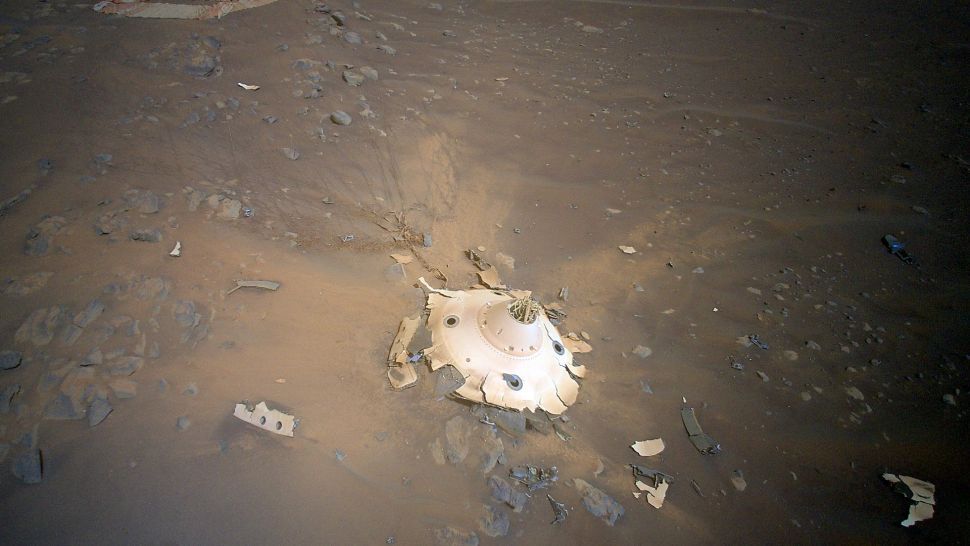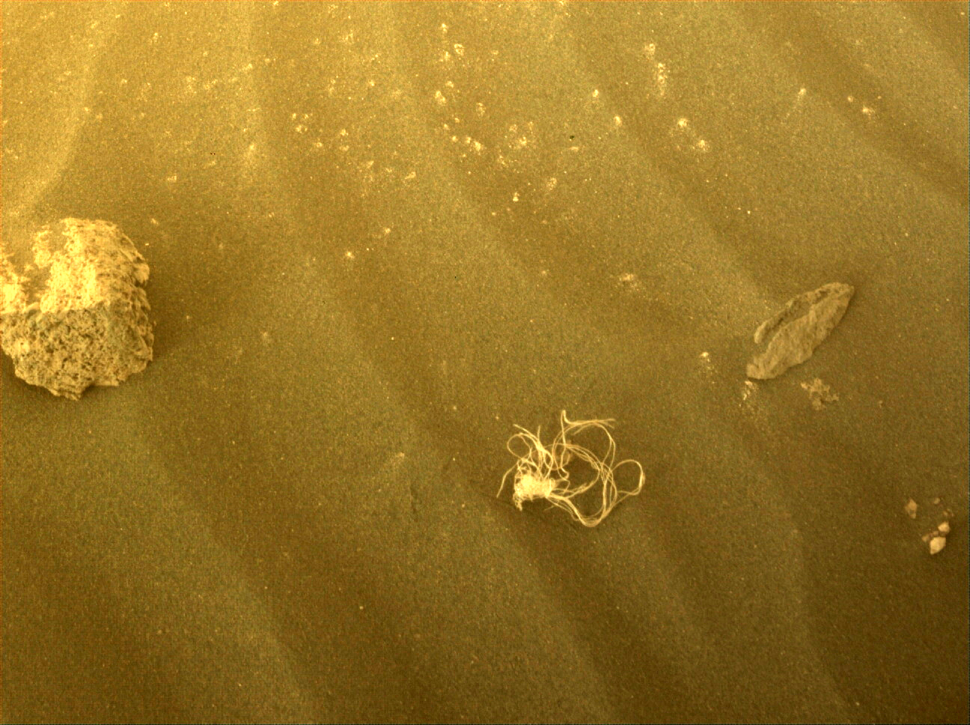8.08.2022
Some of the debris imaged appears to be "subjected to strong forces" — not surprising, given that hardware crashed into the planet.

This image of Perseverance’s backshell sitting upright on the surface of Jezero Crater was collected from an altitude of 26 feet (8 meters) by NASA’s Ingenuity Mars Helicopter during its 26th flight at Mars on April 19, 2022. (Image credit: NASA/JPL-Caltech)
On Mars, there's a unique kind of "tumbleweed" rolling across the Martian plains.
These tumbleweeds aren't plants - they are pieces of debris from the entry, descent, and landing (EDL) hardware from NASA's Perseverance rover. Percy has been coming across many of these remnants, photographing them so that engineers can study them.
During its landing on February 18, 2021, a number of hardware elements slowed the spacecraft's speed from 12,500 mph (20,000 kph) when it first entered the Martian atmosphere to essentially zero miles per hour when it was gently placed on the surface by a sky crane. And that all happened in just seven minutes.
Once their jobs were complete, EDL hardware like the parachute, backshell, heat shield, and the sky crane were all jettisoned from the Perseverance rover, crashing into Mars some distance away from the rover so as not to damage it.
Over the past year and a half, the Perseverance team has spotted and cataloged around half a dozen pieces of suspected EDL debris. The first piece was discovered on April 16, 2022, when an unusually bright object was spotted in one of Perseverance's panoramic Mastcam-Z photos. "The material was given a descriptive name: 'bright material'. No one knew what it was at the time, but perhaps the rover would take a closer look as it climbed up onto the delta in the coming weeks," wrote NASA in a blog post(opens in new tab).
Several months later, Perseverance made it to that place in the delta, called Hogwallow Flats. On June 12, 2022, it photographed the mysterious object, suspected to be a piece of multi-layer insulation (MLI) from the sky crane, made of either Perforated Aluminized Kapton (PAK) or Mylar, that flutters in the wind like a flag. In the same region, the rover also caught a snapshot of a quick-moving knotted ball of "string-like material." That could be Dacron, a netting used in thermal blankets, according to the operations team.

String-like material that the Perseverance rover photographed on the surface of Mars. (Image credit: NASA/JPL-Caltech)
Interestingly, Hogwallow Flats is more than 1.25 miles (two kilometers) away from the crash zones of Perseverance's EDL hardware. "Hogwallow Flats appears to be a natural collecting point for windblown EDL debris," notes NASA.
Perseverance's helicopter companion Ingenuity has gotten up close and personal with some of the EDL debris. On April 19, 2022, Ingenuity flew over the crash site of Perseverance's backshell and parachute, taking high-resolution images of the debris.
Such fields of intentionally discarded debris are not uncommon on Mars, as landings on the Red Planet are typically somewhat violent events. Both the Opportunity and Curiosity rovers have also photographed what's suspected to be their own EDL debris.
For now, landing spacecraft safely on Mars is the number one priority, but as we continue to plant rovers on the planet, researchers will need to consider the effects of such space junk. "Engineers designing EDL hardware for future missions will need to consider the impact (literally) of their designs on both Mars and on the mission requirements," said NASA.
Quelle: SC
